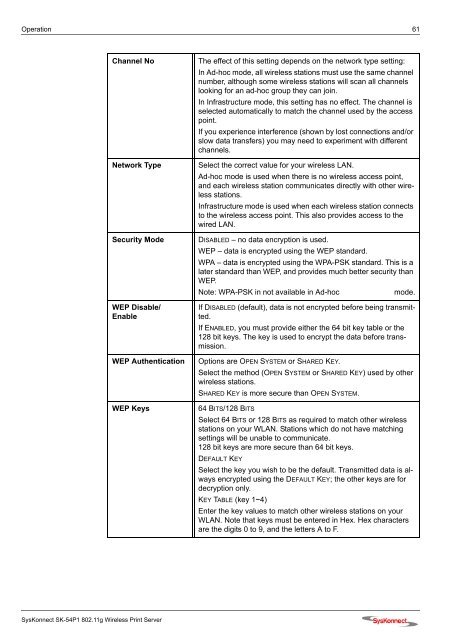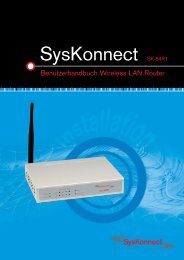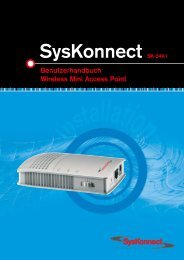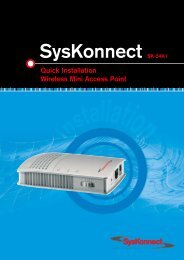Connection to the SysKonnect SK-54P1 802.11g Wireless Print Server
Connection to the SysKonnect SK-54P1 802.11g Wireless Print Server
Connection to the SysKonnect SK-54P1 802.11g Wireless Print Server
Create successful ePaper yourself
Turn your PDF publications into a flip-book with our unique Google optimized e-Paper software.
Operation 61<br />
<strong>SysKonnect</strong> <strong>SK</strong>-<strong>54P1</strong> <strong>802.11g</strong> <strong>Wireless</strong> <strong>Print</strong> <strong>Server</strong><br />
Channel No The effect of this setting depends on <strong>the</strong> network type setting:<br />
In Ad-hoc mode, all wireless stations must use <strong>the</strong> same channel<br />
number, although some wireless stations will scan all channels<br />
looking for an ad-hoc group <strong>the</strong>y can join.<br />
In Infrastructure mode, this setting has no effect. The channel is<br />
selected au<strong>to</strong>matically <strong>to</strong> match <strong>the</strong> channel used by <strong>the</strong> access<br />
point.<br />
If you experience interference (shown by lost connections and/or<br />
slow data transfers) you may need <strong>to</strong> experiment with different<br />
channels.<br />
Network Type Select <strong>the</strong> correct value for your wireless LAN.<br />
Ad-hoc mode is used when <strong>the</strong>re is no wireless access point,<br />
and each wireless station communicates directly with o<strong>the</strong>r wireless<br />
stations.<br />
Infrastructure mode is used when each wireless station connects<br />
<strong>to</strong> <strong>the</strong> wireless access point. This also provides access <strong>to</strong> <strong>the</strong><br />
wired LAN.<br />
Security Mode DISABLED – no data encryption is used.<br />
WEP – data is encrypted using <strong>the</strong> WEP standard.<br />
WPA – data is encrypted using <strong>the</strong> WPA-P<strong>SK</strong> standard. This is a<br />
later standard than WEP, and provides much better security than<br />
WEP.<br />
Note: WPA-P<strong>SK</strong> in not available in Ad-hoc mode.<br />
WEP Disable/<br />
Enable<br />
If DISABLED (default), data is not encrypted before being transmitted.<br />
If ENABLED, you must provide ei<strong>the</strong>r <strong>the</strong> 64 bit key table or <strong>the</strong><br />
128 bit keys. The key is used <strong>to</strong> encrypt <strong>the</strong> data before transmission.<br />
WEP Au<strong>the</strong>ntication Options are OPEN SYSTEM or SHARED KEY.<br />
Select <strong>the</strong> method (OPEN SYSTEM or SHARED KEY) used by o<strong>the</strong>r<br />
wireless stations.<br />
SHARED KEY is more secure than OPEN SYSTEM.<br />
WEP Keys 64 BITS/128 BITS<br />
Select 64 BITS or 128 BITS as required <strong>to</strong> match o<strong>the</strong>r wireless<br />
stations on your WLAN. Stations which do not have matching<br />
settings will be unable <strong>to</strong> communicate.<br />
128 bit keys are more secure than 64 bit keys.<br />
DEFAULT KEY<br />
Select <strong>the</strong> key you wish <strong>to</strong> be <strong>the</strong> default. Transmitted data is always<br />
encrypted using <strong>the</strong> DEFAULT KEY; <strong>the</strong> o<strong>the</strong>r keys are for<br />
decryption only.<br />
KEY TABLE (key 1~4)<br />
Enter <strong>the</strong> key values <strong>to</strong> match o<strong>the</strong>r wireless stations on your<br />
WLAN. Note that keys must be entered in Hex. Hex characters<br />
are <strong>the</strong> digits 0 <strong>to</strong> 9, and <strong>the</strong> letters A <strong>to</strong> F.





